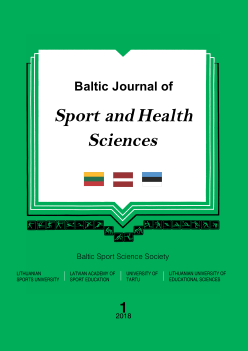Effect of Different Occlusion Pressure on Peculiarities of Muscle Blood Flow
Abstract
Background. Occlusion pressure intensity influences the blood flow intensity. Immediately after the cuff pressure is released, reactive hyperaemia occurs. Increased blood flow and nutritive delivery are critical for an anabolic stimulus, such as insulin. The aim of study was to fnd which occlusion pressure was optimal to increase the highest level of post occlusion reactive hyperaemia. Methods. Participants were randomly assigned into one of the four conditions (n = 12 per group): control group without blood flow restriction, experimental groups with 120; 200 or 300 mmHg occlusion pressure. We used venous occlusion plethysmography and arterial blood pressure measurements. Results. After the onset of 120 and 200 mm Hg pressure occlusion, the blood flow intensity significantly decreased. Occlusion induced hyperaemia increased arterial blood flow intensity 134 ± 11.2% (p < .05) in the group with 120 mmHg, in the group with 200 mmHg it increased 267 ± 10.5% (p < .05), in the group with 300 mmHg it increased 233 ± 10.9% (p < .05). Applied 300 mmHg occlusion from the 12 minute diastolic and systolic arterial blood pressure decreased statistically signifcantly. Conclusions. Occlusion manoeuvre impacted the vascular vasodilatation, but the peak blood flow registered after occlusion did not relate to applied occlusion pressure. The pressure of 200 mmHg is optimal to impact the high level of vasodilatation. Longer than 12 min 300 mmHg could not be recommended due to the steep decrease of systolic and diastolic blood pressures.
Keywords: blood flow restriction, hyperaemia, blood flow intensity, arterial blood pressure.






